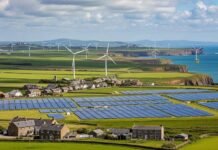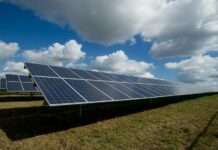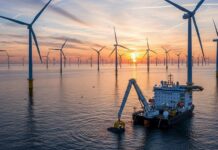With innovative business models and pioneering projects, the finalists of The smarter E AWARD 2019 are driving the sustainable energy industry forward. Projects completed in the areas of solar, storage, energy management and clean transportation take center stage in the Outstanding Projects category.
The Smart Renewable Energy category shines the spotlight on the grid infrastructure of the future, digitalization technologies, the coupling of the electricity, heating and mobility sectors, and business models for electricity trading and marketing. The prizes will be awarded on May 15, 2019 at The smarter E Forum in hall B3, booth B3.570 as part of The smarter E Europe, Europe’s largest platform for the energy industry.
Once again in 2019, the finalists in the Outstanding Projects category show that solar technology is on the rise worldwide and is taking on the role of a key technology. Hybrid concepts, as well as photovoltaics combined with storage technologies, guarantee the availability and stability of renewable energies. This inspires new business ideas and creates opportunities which make a real difference to people’s lives. The trend towards installations operated without feed-in tariffs is also extremely visible.
Finalists in the Outstanding Projects category
• BayWa r.e. renewable energy GmbH (Germany): The Don Rodrigo solar park in southern Spain is the very first European photovoltaic power plant to be financed without subsidies. 500,000 solar modules are installed over an area of 265 hectares, and the total output of the park amounts to 175 MW. At less than 25 euros/MWh, Don Rodrigo’s electricity production costs (LCoE, levelized cost of electricity) are lower than those of conventional power plants. This shows that it is already possible for renewable energies to achieve grid parity in sunny regions of Europe without the need for subsidies.
• Bluestorage (France): A chain of environmentally friendly cinemas which produce their own electricity have been launched under the name of CanalOlympia. 50 entirely selfpowered cinemas are in operation across Central and West Africa. The cinemas are supplied by a hybrid system with 140 kWp of solar modules and 400 kWh of storage. This creates the infrastructure needed for culture and entertainment in rural environments.
• Clean Max Enviro Energy Solutions Pvt. Ltd. (India): A grid-coupled solar park with an output of 145 MWp in Sedam, in the Indian state of Karnataka, is making it easier for companies to switch to solar power with minimal risk. CleanMax is a local green power provider which supplies companies with renewable energy so that they don’t have to invest in their own PV installations. This has made it possible for Adobe India, for example, to cover the entire energy demand of its Bangalore campus with power from the solar park.
• DHYBRID Power Systems GmbH (Germany): Thanks to a hybrid system comprising a photovoltaic installation (200 kWp) and a lithium-ion storage unit (265 kWh), a local utility company in Somaliland (East Africa) can now completely shut down its diesel generators during the day. A smart grid control system is responsible for fully automatic and loaddependent control and regulation of all energy sources. The share of renewable energies can be expanded in similar applications with this system, regardless of the manufacturer or technology.
• IBC SOLAR Energy GmbH (Germany): The Michaelshof project in Sammatz (Wendland) demonstrates that a village in Germany can power itself with locally generated renewable energy. A total of 190 kWp of photovoltaics have been installed on nine buildings and 90 percent of the solar power is consumed on-site. In combination with a 200 kWh lithium battery system, the prosumers achieve a self-sufficiency rate of around 40 percent.
• Japan Tobacco International (Jordan): This tobacco factory in Amman generates both industrial process heat and cooling using Fresnel collectors. This is the first time that solar process steam generation and solar thermal cooling have been combined anywhere in the world. The Jordanian tobacco factory was fitted with a collector array spanning 1,254 square meters, and a two-stage absorption refrigerator is also used.
• mondas GmbH (Germany): A smart heating network has been set up in Gutleutmatten, a newly developed residential area in Freiburg, featuring 38 decentralized solar thermal installations. A total of 525 dwellings with 1,350 residents are connected to the heating network. AI algorithms and a specially developed IoT (Internet of Things) web platform take care of energy management for the solar collectors, the decentralized hot water storage tanks and the centralized cogeneration systems.
• NEXTracker, Inc. (USA): The 1.1 MW solar power plant at the Maharishi University of Management is the first solar installation in the USA to combine active tracking technology and vanadium-flow battery energy storage. The system uses a smart tracker control system which enables each row of modules to move independently to compensate for shading, weather conditions or the topography of the site in real time. The new solar and storage power plant brings the share of renewable energies in the university’s total energy supply to around 43 percent, and is predicted to cut its power bill by 30 percent.
• Siemens AG (Germany): The hybrid power plant Isabela, situated on the largest Galapagos island, supplies almost 900 households with carbon-neutral power from solar energy and biofuels. In addition to the 952 kWp photovoltaic installation and a battery storage system with a capacity of 330 kWh, it also includes a diesel generator with an output of 1,625 kW. The oil of the native plant jatropha is used as a biofuel. Thanks to the smart control unit, a PV forecasting system and the accumulators, the diesel generator can be turned off when the sun is shining.
• Solare Datensysteme GmbH (Germany): The two-stage control system Solar-Log ensures that feed-in limits are complied with, even if the total output of two photovoltaic installations exceeds the limits. This means there is never more power being fed into the grid than is specified by the utility company. In addition, as much power as possible is retained for self-consumption. Grid operators can now accept requests they previously had to refuse.
Finalists in the Smart Renewable Energy category
The future of renewable energies is heavily dependent on digitalization along the entire value-added chain. A wave of new digital services, products and solutions are currently under development. These bring flexibility and security to the decentralized energy market, as well as coordinating generation and consumption.
• Axiotherm GmbH (Germany): kraftBoxx, a thermal energy storage unit for heating and hot water using latent storage sticks, boasts a considerably higher energy storage capacity than conventional heat and cold storage systems without taking up any more space. The sticks can also be retrofitted in existing systems. Depending on the desired operating point of the heat or cold storage system, the sticks are filled with different media to optimize them for specific temperature ranges. Due to its high energy storage capacity, kraftBoxx is ideal for sector coupling in single-family homes.
• GOLDBECK Solar GmbH (Germany): Goldbeck’s energy optimization software GEOS can be used in the early stages of a project to compare economic and ecological evaluations of different renewable energy supply concepts for office buildings. This enables fact-based comparison of alternatives with each other and with the standard, so that the most costefficient and sustainable solution can be found.
• PION Technology AG (Germany): The modular AC charging station plays a central role in the infrastructure for electric vehicles. Shaped like a board game piece, the small and stable concrete charging station provides charging power of up to 22 kW. This elegant yet solid piece of street furniture is extremely user-friendly. The housing material sequesters particulate matter and removes nitrogen oxides from the air.
• Reuniwatt (France): With SunSat Digital Twin, operators can monitor the condition of their solar power plant without even needing to measure the radiation on-site at any point. The actual yield is continuously compared with the target yield using solar radiation data determined by satellite. This provides useful insights into reduced yields and helps the owner or operator to identify potential errors at an early stage.
• Smappee (Belgium): The modular energy management system Smappee Infinity, which can also be retrofitted, analyzes the energy flows in a household and displays them visually in a smartphone app. This helps to identify major electrical loads, which can then be turned on and off as required. Loads can be controlled according to the time of day to ensure that as much as possible of the energy generated is consumed on-site. The system can also time electric vehicle charging to make use of cheaper tariffs whenever possible, for example, or configure charging so as not to exceed specific load limits at the house connection point.
• SolarEdge Technologies Inc. (Israel): SolarEdge’s virtual power plant solution groups together decentralized energy generation installations to create a virtual power plant, and coordinates them to offer grid services or contribute to grid stability. The software platform operates independently of the hardware of individual energy generation plants. The intelligent combination of decentralized and cloud-based processing power ensures that latency is kept to a minimum, which is necessary for grid services.
• SolarGaps (Ukraine): These solar blinds do not only provide shade, they also bring down the electricity bill. The blinds are supplied with microinverters which convert DC into AC so that electrical appliances can be recharged directly from the junction box. The PV blinds can be controlled by smartphone app or, alternatively, adjust themselves automatically for optimal sun exposure.
• Solargis (Slovakia): The software solution Prospect displays a complete yield simulation for small, medium and large-scale photovoltaic power plants. Based on averaged weather and radiation data from a range of sources, the technical simulation of the photovoltaic installation provides a reliable yield forecast. The result is then automatically presented in a
clear and comprehensive report.
• SolarInvert GmbH (Germany): Selv-PV is a compact, intelligent energy system made up of a 1.68 kWp photovoltaic installation (six solar modules) and a 2.5 kWh storage device. The system is designed for self-consumption of solar power in private households. It is equipped with all the necessary protective features and can easily be connected to an AC power socket.
• Stäubli Electrical Connectors AG (Germany): The Power-Blox battery units feature ports for PV modules as well as outlets for 230 V alternating current and 12 V and 9 V direct current. The energy cubes with an integrated battery are the basic components of a self configuring system. Connecting several storage devices creates a distributed grid without central storage unit. As it does not require any advance planning, the system is suitable for both temporary and permanent electricity supply in regions without a stable grid.
Further information on the AWARDs can be found here:
• The smarter E AWARD: www.TheSmarterE-award.com
• Intersolar AWARD: www.intersolar-award.com
• ees AWARD: www.ees-award.com
About The smarter E
The smarter E is the world’s leading exhibition and conference series for new energy solutions. Digitalization and decentralization are changing the face of the energy world for good, and the steady rise in electricity from volatile and renewable sources requires new concepts and solutions for generating, storing, distributing and using energy efficiently. The smarter E unites exhibitions and conferences on four continents that take an in-depth look at these topics.
Intersolar is the world’s leading exhibition series for the solar industry and its partners. It focuses on photovoltaics, solar thermal technologies, solar power plants, grid infrastructure, and solutions for the integration of renewable energies. Since being founded 28 years ago, Intersolar has become the most important industry platform in the global solar industry.
ees is the leading exhibition for batteries and energy storage systems and the industry platform for suppliers, manufacturers, distributors and professional users of stationary energy storage solutions and battery systems along the entire supply chain.
Power2Drive reflects the opportunities and necessity of the energy transition in the transportation sector. The focus is on traction batteries for electric vehicles as well as infrastructure solutions and technologies for clean mobility.
At EM-Power, professional energy customers – with their demand for efficient energy technologies, intelligent control systems and energy savings – and the key concepts underpinning the energy transition in industry and the building sector take center stage.

































